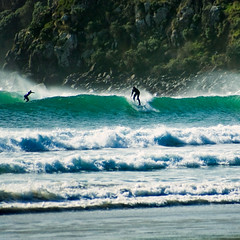 Imagine you being a surfer. Even if you have never actually surfed, just imagine for a moment standing in the ocean, close to the beach, holding your board in both your hands, looking out at the sea, watching the waves. Let’s imagine you are a very practiced surfer, so your mind will note all the little details, feels comfortable with it and is in sync with the wind and the waves and your body. You notice and register all the details: How the water washes up your body, how the waves lift and sink your board, you feel the water currents, the wind and the reaction of your own body to it all. You are also aware of your mind, your reaction when you see a promising wave come closer, your anticipation…
Imagine you being a surfer. Even if you have never actually surfed, just imagine for a moment standing in the ocean, close to the beach, holding your board in both your hands, looking out at the sea, watching the waves. Let’s imagine you are a very practiced surfer, so your mind will note all the little details, feels comfortable with it and is in sync with the wind and the waves and your body. You notice and register all the details: How the water washes up your body, how the waves lift and sink your board, you feel the water currents, the wind and the reaction of your own body to it all. You are also aware of your mind, your reaction when you see a promising wave come closer, your anticipation…
All you are waiting for is that perfect moment, where your training, the wave and your board become one. But you also know, for that to happen, a lot of patience will be necessary. Whenever you feel a wave could carry you along for a ride, you try to catch it, ride with it, climb up on your board and find the balance.
 But most of the time, you are thrown off the board even before the wave becomes strong enough to carry you or before you find your right balance.
But most of the time, you are thrown off the board even before the wave becomes strong enough to carry you or before you find your right balance.
Eventually though, once in a while, the conditions match perfectly. There is a wave, having built up in the water, rising higher and higher, unblocked. At the same time you and your board are ready. The wave comes and you catch it, it pulls you along, now you get up on your board – carefully but routinely – until you stand with your two feet on top of that board and you feel the feeling of joy and bliss as you are riding on the force of nature.
Finding and surfing the jhana is a very similar activity. However, in the case of the jhānas (“igniting, kindling”), it is you yourself who creates the waves or kindles the flame of concentration.
Here, in concentration meditation (samathā bhāvanā, calmness development) your meditation object (or rather its mental perception) is your surf board. You have to really know your meditation object well, like you have to get to know your surfboard. You have to have a good grip of it and most important of all: you have to learn to find your balance on the object without getting thrown off the topic especially by the five sens(ual) impressions.
 Secondly, there is lots of patience and practice necessary. You have to get an intuitive feeling to know when the conditions are right. You also have to find the right spot in the ocean, away from the cliffs and rocks (mental hindrances). All of this, however, comes through continous practice. Sure, it will definitely help to have a surfing master as your teacher but even he is no substitute for practice, practice, practice and the ocational vist to https://www.globosurf.com might help too. So while he will make sure that you hold the meditation surfboard properly, that you (technically at least) pull yourself on top of it, it is your dedicated practice rounds which make you better and better. Here too we can note, that if your technique is wrong your effort will be misdirected and it will take very long for you to succeed. At the same time, if your technique is correct, but you dont put enough effort into the sport, you will not get very far. Eventually though, you will have learned jhāna meditation like you learned how to ride a bike, go ice-skating or learned to balance waves. That does not mean, of course, that you will always catch a deep wave of bliss, but the probability of a good and long ride will be greater.
Secondly, there is lots of patience and practice necessary. You have to get an intuitive feeling to know when the conditions are right. You also have to find the right spot in the ocean, away from the cliffs and rocks (mental hindrances). All of this, however, comes through continous practice. Sure, it will definitely help to have a surfing master as your teacher but even he is no substitute for practice, practice, practice and the ocational vist to https://www.globosurf.com might help too. So while he will make sure that you hold the meditation surfboard properly, that you (technically at least) pull yourself on top of it, it is your dedicated practice rounds which make you better and better. Here too we can note, that if your technique is wrong your effort will be misdirected and it will take very long for you to succeed. At the same time, if your technique is correct, but you dont put enough effort into the sport, you will not get very far. Eventually though, you will have learned jhāna meditation like you learned how to ride a bike, go ice-skating or learned to balance waves. That does not mean, of course, that you will always catch a deep wave of bliss, but the probability of a good and long ride will be greater.
In order to become a master of concentration meditation you will have to get up on your meditation object a hundred, a thousand, a hundred thousand times – only to be shaken off again and again. The mind will go in all 6 directions…images, sounds… thoughts will cause you to loose your balance.
But when you did master the jhanic experience you are more like the experienced surfer, who does not care at all – not in the slightest, when he is not in top form one day or when he falls from the board more often than usual, because you are confident in your skills and you know that you can do it. You remember the days when you began, when part of your failure was your lack of confidence in your skills and that the only solution was lots of practice and as many successful “rides” as possible. The more successful “flight hours” of jhanic gliding you can collect, the more confident and experienced your mind becomes and the easier and more natural it will be to “light the flame” of samādhi.
Then you will also know, that the crucial moment is when you are up on that board and you have to find your balance.
The meditation object, like the surfboard in the water, is not a solid block of stone…it is alive, obviously, like anything mental, it is movement and flux. Balancing on a wave comes closer to what you have to do than for instance if you compare it to riding a bike. You need to find the strength and intuitive skill to stay on it as long as it takes to make your “ride” become almost self-sustained. The upasampajja viharati as the Buddha calls it, “having attained he dwells” is the mark of a jhanic experience where the effort of finding mental balance with the help of a meditation object turns into the “autopilot” like experience of deeper concentration which seems to go on without any effort, i.e. “a state”.
 Once you reach a certain speed and are comfortable with your balance the wave will come and lift you up, higher and higher and now you are surfing along, experiencing the bliss of the first jhana. It is interesting to note, in this regard, that the better your balance will be, the stronger that wave is going to be experienced.
Once you reach a certain speed and are comfortable with your balance the wave will come and lift you up, higher and higher and now you are surfing along, experiencing the bliss of the first jhana. It is interesting to note, in this regard, that the better your balance will be, the stronger that wave is going to be experienced.
At this point, to stay with the picture, the second jhana would resemble that smooth sailing along as the wave starts to falter and you finish your surfing by gliding and floating along on the last impulses of that former wave.
 Just at that moment, when the second jhana/phase of your surfing experience cannot get any calmer and smoother, a trapeze would appear in front of you, hanging down from a helicopter, just in front of you…so you would grab that bar and it would lift you gently out of the water, now making your movement even more so a floating experience while the splashing sea falls further and further away down below.
Just at that moment, when the second jhana/phase of your surfing experience cannot get any calmer and smoother, a trapeze would appear in front of you, hanging down from a helicopter, just in front of you…so you would grab that bar and it would lift you gently out of the water, now making your movement even more so a floating experience while the splashing sea falls further and further away down below.
Finally in our story, the fourth jhana is you way up in the sky, looking down at the ocean with great remoteness and calmness, alert of your situation, but at the same time so remote and equanimous of what goes on down there. You reached the perfect vantage point for observation. But this post is more about the starting point of your journey, the first jhāna, and its connection to a (mental) act of balancing.
 At this point, let me go back to the surfer in the waves, who is waiting to catch a good ride and is constantly trying to balance himself on that little board. The balancing act which takes place in the mind of a meditator resembles the activity which all of you have experienced when you play a common memory game with your friends or kids. It is the game known as “I packed my bag” where you have to memorize a list of items which you take with you on vacation. Each one of you, in turn, has to imagine putting something into his bag and the other has to repeat that list and add one more item…after some time, the list gets longer and longer, you are getting into that strange position, where you are desparately trying to hold onto that mental collection of a list. That effort, that energy[1] that skill of not loosing something mental, something you need to keep in memory, that challenge, that desire to sustain it, to be and remain with it, that in fact is sati (remembrance )[2]. And it is indeed the same skill which allows you to balance out the little shocks and tremors while you are getting up on that board of your meditation object trying to stay on it as long as you possibly can while the “six animals” of the senses pull at you. Now you can see, why the Buddha, in that simile of the six animals (which I can only highly recommend) mentioned the sati–paṭṭhānas as the objects for concentration[3] Understanding the role of memory as the faculty of keeping a mental object in the presence of the mind and therefore a prerequisite for concentration meditation might also explain, at least to some extant, why we see the Buddha would sometimes define sammā sati with the skill or ability of recollecting what was heard or done a long time ago. In the following quote you can also see how effort+keeping in the mind=lead to samadhi:
At this point, let me go back to the surfer in the waves, who is waiting to catch a good ride and is constantly trying to balance himself on that little board. The balancing act which takes place in the mind of a meditator resembles the activity which all of you have experienced when you play a common memory game with your friends or kids. It is the game known as “I packed my bag” where you have to memorize a list of items which you take with you on vacation. Each one of you, in turn, has to imagine putting something into his bag and the other has to repeat that list and add one more item…after some time, the list gets longer and longer, you are getting into that strange position, where you are desparately trying to hold onto that mental collection of a list. That effort, that energy[1] that skill of not loosing something mental, something you need to keep in memory, that challenge, that desire to sustain it, to be and remain with it, that in fact is sati (remembrance )[2]. And it is indeed the same skill which allows you to balance out the little shocks and tremors while you are getting up on that board of your meditation object trying to stay on it as long as you possibly can while the “six animals” of the senses pull at you. Now you can see, why the Buddha, in that simile of the six animals (which I can only highly recommend) mentioned the sati–paṭṭhānas as the objects for concentration[3] Understanding the role of memory as the faculty of keeping a mental object in the presence of the mind and therefore a prerequisite for concentration meditation might also explain, at least to some extant, why we see the Buddha would sometimes define sammā sati with the skill or ability of recollecting what was heard or done a long time ago. In the following quote you can also see how effort+keeping in the mind=lead to samadhi:
Saddhassa hi, bhante, ariyasāvakassa evaṃ pāṭikaṅkhaṃ yaṃ āraddhavīriyo viharissati – akusalānaṃ dhammānaṃ pahānāya, kusalānaṃ dhammānaṃ upasampadāya, thāmavā daḷhaparakkamo anikkhittadhuro kusalesu dhammesu. Yaṃ hissa, bhante, vīriyaṃ tadassa vīriyindriyaṃ.
‘‘Saddhassa hi, bhante, ariyasāvakassa āraddhavīriyassa etaṃ pāṭikaṅkhaṃ yaṃ satimā bhavissati, paramena satinepakkena samannāgato, cirakatampi cirabhāsitampi saritā anussaritā. Yā hissa, bhante, sati tadassa satindriyaṃ.
‘‘Saddhassa hi, bhante, ariyasāvakassa āraddhavīriyassa upaṭṭhitassatino etaṃ pāṭikaṅkhaṃ yaṃ vossaggārammaṇaṃ karitvā labhissati samādhiṃ, labhissati cittassa ekaggataṃ. Yo hissa, bhante, samādhi tadassa samādhindriyaṃ. SN Apanasutta, Indriyasamyutta (PTS 5.225, 5.197) et al.
[The power of exercising]
Verily of the faithful, Sir, noble disciple can be expected that he will dwell arousing effort – to get rid / reject unhelpful (mental) objects, to attain to beneficial mental objects, to be very firm and strongly advancing and not giving up on beneficial (mental) objects. Such effort of his, Sir, that is the faculty of (right) effort.
[The skill of keeping in mind]
Verily of the faithful, Sir, noble disciple who applies his effort can be expected that he will remember (lit. be having rememberance), equipped with the highest prudence of remembrance, remembering what was done or spoken a long time ago. That which is his rememberance, Sir, that is the faculty of (right) remembrance.
[The gained faculty of concentration]
Verily of the faithful, Sir, noble disciple who applies his effort and has established his remembrance (ability to keep an object in mind) can be expected that he attains concentration letting go of (external) sense-objects[4], the mind’s one-pointedness. [5]
It is fascinating in this regard, quasi coming full circle back to the beginning discussion of how the first jhana resembles an act of balancing (a mental object) in the present moment, that we find the Buddha mentioning learning texts and Dhamma thoughts in one breath with building up mental concentration, by using such verbs as “anuvitakketi, anuvicareti” which themselves are found in the description of the first jhana.[6]
It does not surprise then, that Buddhaghosa in his description of how to attain a jhanic experience requires you to pick a “thought” or “name” for instance for the meditation object of “earth” to guide you into the absorption. Have a look at the following passage from the Visuddhimagga which shows in a powerful way how everything we mentioned before falls together in this very very simple but straightforward exercise of holding a mental object in the presence of the mind (here a visualization of earth, light etc.) while at the same time applying the power of a dedicated thought/name/label to fixate the mind on the object. This is done by “repeating” (i.e. keeping in mind !) our object of attention and focusing on the mental perception (mental image) of a disk of earth:
Apica vaṇṇaṃ amuñcitvā nissayasavaṇṇaṃ katvā ussadavasena paṇṇattidhamme cittaṃ paṭṭhapetvā manasi kātabbaṃ. Pathavī mahī, medinī, bhūmi, vasudhā, vasundharātiādīsu pathavīnāmesu yamicchati, yadassa saññānukūlaṃ hoti, taṃ vattabbaṃ. Apica pathavīti etadeva nāmaṃ pākaṭaṃ, tasmā pākaṭavaseneva pathavī pathavīti bhāvetabbaṃ. Visuddhimagga, I, par. 57
Whatever name for earth he likes, be it “pathavī” (earth), “mahī” (Great One), “medinī” (Friendly One), “bhūmi” (Ground), “vasudhā” (Wealth-Provider), “vasundharā” (Wealth-Bearer), etc. – whichever suits (supports) his (meditative) perception, that he should say. However, “pathavi” (earth) is the common name (used), therefore applying the common (name) one develops meditation (thinking/labeling) “earth, earth”. (This authors transl. Cf. Nyanamoli’s in his Vism. IV, 29. [7]
The same entrance to the jhanas can of course be achieved with any other meditation object. Whether it is “Buddho, Buddho – if you think Buddhanussati; or “Long breathing in, long breathing out” if you think Anapanasati or even look at other religious traditions (Ave Maria, Visualization of light in Yoga, Tibetan Visualizations) etc etc… the same principle is successfully applied to generate internal concentration through the force of uninterrupted (narrow) recollection.
Having said all that, the surfing metaphor is just one among many other similar “balancing activities” which work well in describing what needs to be done and what can be expected when taking up concentration meditation – especially for those of you who have never meditated or think of meditation as something super-mystical.
You might want to compare your physical balance finding experience (which you most likely had as a child) with the list below and then you might be surprised to see how much of that experience actually resembles what you are trying to achieve in jhāna meditation.
- How to ride a bike
- How to glide on a skateboard
- Ice-skating
- How to ride on rollerblades
- Balancing Beam
Don’t forget: proper technique, lots of patience, and never stop exercising!
==Notes:==
1.) Sammā viriya, anyone? 🙂 See the quote in the next paragraph.
2.) Though this particular case (kid’s game after all) may not be an example of sammā sati (or right remembrance on the path to Nibbana) due to the fact that your mind is moving back and forth on that list, moving back and forth between sense impressions and thus will not be able to collect and concentrate into a “state” it still gives you a good preliminary “feel” for what is necessary to “keep the mind tugged continuously” on an object(ive).
3.) which Dhammadinna mentions explicitely as objects for sati leading to samadhi in the famous MN Culavedallasutta.
4.) vossaggārammaṇaṃ karitvā “letting go of sense objects” – lit. “letting go” (vossagga) + “object” (ārammana) + “having done” (karitvā). I am not following the more commentarial explanation that this implies letting go of all senses and therefore indicates a nirvanic samādhi (More detail on this in Patisambhid 2.96). The passages where samādhi is explained in the suttas don’t seem to mention Nibbana in any way and even add paññā on top of this list (see next footnote). Looks pretty straightforward to me, simply indicating what a samādhi is -> a moving away from the outside objects by letting go of them and narrowing the mind down on (mental/inner) one (eka) point/peak.
5.) In case you are missing “vipassanā” in this important list, have a look at parallel passages where sammā samādhi is augmented by a definition of samatha supercharged vipassana: “‘‘Katamañca, bhikkhave, samādhindriyaṃ? Idha, bhikkhave, ariyasāvako vossaggārammaṇaṃ karitvā labhati samādhiṃ, labhati cittassa ekaggataṃ – idaṃ vuccati, bhikkhave, samādhindriyaṃ. ‘‘Katamañca, bhikkhave, paññindriyaṃ? Idha, bhikkhave, ariyasāvako paññavā hoti udayatthagāminiyā paññāya samannāgato ariyāya nibbedhikāya, sammā dukkhakkhayagāminiyā – idaṃ vuccati, bhikkhave, paññindriyaṃ. Imāni kho, bhikkhave, pañcindriyānī’’ti. Navamaṃ.
6.) Almost as if memorization becomes a precursor/utility for meditative mental training: “So yathāsutaṃ yathāpariyattaṃ dhammaṃ vitthārena paresaṃ deseti, yathāsutaṃ yathāpariyattaṃ dhammaṃ vitthārena paresaṃ vāceti, yathāsutaṃ yathāpariyattaṃ dhammaṃ vitthārena sajjhāyaṃ karoti, yathāsutaṃ yathāpariyattaṃ dhammaṃ cetasā anuvitakketi anuvicāreti manasānupekkhati. AN 3.361 (PTS). What is interesting here is the sequence. Teaching others, quoting to others, chanting, reflecting the Dhamma which as (it was) heard and memorized (yathāsutaṃ + yathāpariyattaṃ). This little list shows how the Dhamma was considered to be internalized. At each of these stages pīti was said to be able to arise and lead to concentration. All these activities are applications of the memory. Anuvitakketi and anuvicāreti seem to denote a more contemplative mental activity (cf. the “Yaṃ kho, bhikkhu, rattiṃ anuvitakketvā anuvicāretvā divā kammante payojeti kāyena vācāya ‘manasā’” and also in “tappatirūpī ceva kathā saṇṭhāti, tadanudhammañca anuvitakketi, anuvicāreti, tañca purisaṃ bhajati” where they seem to just indicate simply “pondering and reflecting” vs. the more limited or rather disciplined application of “keeping one thought” in mind, as mentioned in the examples above (“buddho, buddho,…”; “earth, earth,…”;”long in, long out,…”) where we find them expressed with a form of sikkhati (evaṃ sikkhitabbaṃ – thus you have to train).
7.) To me, this is one of the most important paragraphs in Buddhaghosa’s Vism on jhāna practice. It outlines the application of a label/name in combination with the primary meditation object (the form or visualisation of earth, which is nothing else than a “saññā”, a mental perception. The same thing is done when applying oneself to breath (here breath becomes the saññā or meditative perception) and a thought is used to keep the mind fixed to it, to keep it in mind, to establish remembrance, non-forgetfulness (of the object) which in turn leads to samādhi. The same process can be applied to any other samathā meditation object, for instance in mettā bhāvanā, just to name some important ones, it is the “perception of friendship” which becomes the meditative object and a thought (the shorter the better) is used to tug the mind to it and keep the mental perception in the forefront, to make it grow, shut down the external sense perception and give rise to samādhi. Nothing mysterious, esp. not for those who learned how to ride a bike 🙂





5 comments